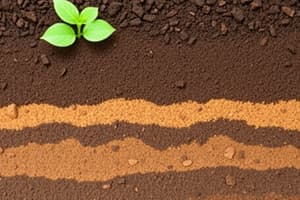Podcast
Questions and Answers
Which soil layer is primarily responsible for contributing to soil fertility due to its high carbon and nitrogen contents?
Which soil layer is primarily responsible for contributing to soil fertility due to its high carbon and nitrogen contents?
- Subsoil
- Bedrock
- Topsoil
- Organic layer (correct)
What is humus primarily responsible for in soil?
What is humus primarily responsible for in soil?
- Reducing water retention
- Decreasing aeration
- Improving soil texture and adding valuable nutrients (correct)
- Decreasing soil fertility
Which component of soil is formed when plant remains decompose very slowly over several years?
Which component of soil is formed when plant remains decompose very slowly over several years?
- Humus (correct)
- Organic layer
- Subsoil
- Bedrock
What is the primary function of the organic layer in soil?
What is the primary function of the organic layer in soil?
How does understanding soil layers contribute to sustainable farming practices and conservation strategies?
How does understanding soil layers contribute to sustainable farming practices and conservation strategies?
What distinguishes topsoil from subsoil in terms of biological activity?
What distinguishes topsoil from subsoil in terms of biological activity?
Why do many plant roots reside in the topsoil layer?
Why do many plant roots reside in the topsoil layer?
Which layer plays a crucial role in anchoring plants through its loose granular structure?
Which layer plays a crucial role in anchoring plants through its loose granular structure?
What is the primary function of bedrock in soil ecosystems?
What is the primary function of bedrock in soil ecosystems?
Which component of soil is responsible for enriching the soil with nutrients and aiding in moisture retention?
Which component of soil is responsible for enriching the soil with nutrients and aiding in moisture retention?
Flashcards are hidden until you start studying
Study Notes
Exploring Soil Layers
Soil is more than just dirt under our feet; it's a complex ecosystem with distinct layered components known as soil horizons. These layers serve vital functions such as water retention, nutrient reserves, and plant growth support. Let's delve into each of these essential parts of soil: topsoil, subsoil, bedrock, and their integral constituents – the organic layer and humus.
Topsoil
Topsoil represents the uppermost portion of the first soil horizon. It typically ranges from only several centimeters up to about one meter deep (though deeper in some cases), depending upon factors like climate, parent material, and time since formation. This layer contains most of the living organisms and organic matter found within the soil profile. Additionally, many plant roots reside here because this zone has the highest concentrations of nutrients and moisture available.
Subsoil
Subsoil, also called subhorizon, follows directly beneath the topsoil. Its depth may vary between two meters downward. Although containing fewer biological activities compared to the topsoil, it plays crucial roles in anchoring plants via the root system that grows through its loose granular structure, providing pathways for water movement while offering resistance during heavy rainfall events.
Bedrock
Bedrock lies below the subsoil and is essentially rocky, impermeable material that prevents further soil development. Understanding the presence of bedrock helps determine how deeply cultivated soils can develop based on geological conditions.
Organic Layer
The organic layer consists primarily of decomposed plant materials, which form part of the humus group, contributing to soil fertility due to its high carbon and nitrogen contents. Also referred to as the O horizon, it retains moisture effectively, mostly by working together with clay particles present in the underlying mineral soil layers. Depending on specific environmental circumstances, this organic layer might take on various forms, including peat bogs, mosses, leaf litter, mucky forests, etc..
Humus
Humus is a dark brownish to black organic substance formed when plant remains decompose very slowly over several years—the result of microorganisms such as bacteria, fungi, and protozoa breaking down dead vegetal matter. Highly stable yet easily soluble, humus improves soil texture, increases water retention capacity, boosts aeration, and adds valuable nutrients to agricultural lands. Composting and mulching processes help accelerate humus production naturally.
Understanding soil layers and the critical role they play in agriculture and natural environments contributes significantly to sustainable farming practices and conservation strategies alike. By appreciating these individual components, land managers, farmers, and researchers can implement innovative techniques designed to improve soil health and productivity while preserving the environment.
Studying That Suits You
Use AI to generate personalized quizzes and flashcards to suit your learning preferences.




